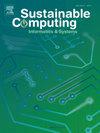Scalable and low-power reversible logic for future devices: QCA and IBM-based gate realization
IF 5.7
3区 计算机科学
Q1 COMPUTER SCIENCE, HARDWARE & ARCHITECTURE
引用次数: 0
Abstract
One such revolutionary approach to changing the nano-electronic landscape is integrating reversible logic with quantum dot technology that will replace the conventional complementary metal-oxide semiconductors (CMOS) circuits for ultra-high speed, low density, and energy-efficient digital designs. The implementation of the reversible structure under the most inflexible conditions, as executed by quantum laws, is a highly challenging task. Furthermore, the enormous occupying areas seriously compromise the accuracy of the output in quantum dot circuits. Because of this challenge, quantum circuits can be employed as fundamental building blocks in high-performance digital systems since their implementation has a key impact on overall system performance. This study discusses a paradigm shift in nanoscale digital design by using a 4 × 4 reversible gate that redefines the basis of efficiency and precision. This reversible gate is elaborately used in a reversible full-adder circuit, fully symbolizing the core of minimum area, ultra-low energy consumption, and perfect output accuracy. The proposed reversible circuits have been fully realized using quantum-dot cellular automata technology (QCA), simulated, and verified by the highly reliable tool such as Qiskit IBM and QCADesigner 2.0.3. Furthermore, simulations results demonstrated the superiority of the QCA-based proposed adder, which reduced occupied area by 7.14 %, and cell count by 11.57 %, respectively. This work resolves some problems and opens new boundaries toward the future of digital circuits by addressing the main challenges of stability and pushing the boundaries of reversible logic design.
未来器件的可扩展和低功耗可逆逻辑:QCA和基于ibm的栅极实现
一种革命性的方法是将可逆逻辑与量子点技术相结合,以取代传统的互补金属氧化物半导体(CMOS)电路,实现超高速、低密度和节能的数字设计。根据量子定律,在最不灵活的条件下实现可逆结构是一项极具挑战性的任务。此外,巨大的占位面积严重影响了量子点电路输出的精度。由于这一挑战,量子电路可以作为高性能数字系统的基本构建模块,因为它们的实现对整个系统性能有关键影响。本研究通过使用4 × 4可逆栅极,讨论了纳米级数字设计的范式转变,重新定义了效率和精度的基础。该可逆栅极被精心应用于可逆全加法器电路中,充分体现了最小面积、超低能耗、完美输出精度的核心。采用量子点元胞自动机技术(quantum-dot cellular automata technology, QCA)完全实现了所提出的可逆电路,并通过Qiskit IBM和qcaddesigner 2.0.3等高可靠性工具进行了仿真和验证。此外,仿真结果证明了基于qca的加法器的优越性,其占用面积和细胞计数分别减少了7.14 %和11.57 %。这项工作解决了一些问题,并通过解决稳定性的主要挑战和推动可逆逻辑设计的边界,为数字电路的未来开辟了新的边界。
本文章由计算机程序翻译,如有差异,请以英文原文为准。
求助全文
约1分钟内获得全文
求助全文
来源期刊

Sustainable Computing-Informatics & Systems
COMPUTER SCIENCE, HARDWARE & ARCHITECTUREC-COMPUTER SCIENCE, INFORMATION SYSTEMS
CiteScore
10.70
自引率
4.40%
发文量
142
期刊介绍:
Sustainable computing is a rapidly expanding research area spanning the fields of computer science and engineering, electrical engineering as well as other engineering disciplines. The aim of Sustainable Computing: Informatics and Systems (SUSCOM) is to publish the myriad research findings related to energy-aware and thermal-aware management of computing resource. Equally important is a spectrum of related research issues such as applications of computing that can have ecological and societal impacts. SUSCOM publishes original and timely research papers and survey articles in current areas of power, energy, temperature, and environment related research areas of current importance to readers. SUSCOM has an editorial board comprising prominent researchers from around the world and selects competitively evaluated peer-reviewed papers.
 求助内容:
求助内容: 应助结果提醒方式:
应助结果提醒方式:


